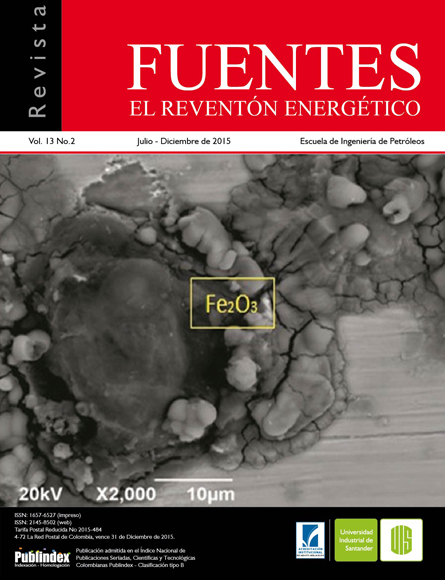Published 2015-12-03
Keywords
- AISI sae 4330 steel,
- Corrosion rate,
- Drilling mud,
- Electrochemical techniques,
- Polarization resistance
How to Cite
Abstract
Drilling fluids also known as drilling muds play a very important role in the oil and gas industry. Muds can be oil-based or water-based. Oil-based fluids have limited application due environmental problems. On the other hand, water-based muds are usually corrosive. Drilling muds have different functions such as the transport of drill cuttings to the surface, cooling, cleaning and lubrication of the drill bit and the drill collars as well as maintaining the stability of the well and the prevention of any escape of gas or oil. It is expected that the mud will not cause excessive wear or corrosion to the materials used in the drillstring. In this study the corrosion of the AISI 4330 steel in contact with a water-based drilling mud was evaluated using the electrochemical techniques Tafel extrapolation
and impedance spectroscopy. The corrosion tests were performed at temperatures of 30, 45 and 60 ° C and rotation rates of 1000, 2000, 3000 rpm using a rotating cylinder electrode (ECR).
Therefore, downhole and surface service conditions were simulated. It was found that the rotation rate is the most influential variable on the corrosion rate of the aisi 4330 steel. With increasing the rotation rate the corrosion current density increased and the polarization resistance decreased, consequently, the corrosion rate of the investigated steel increased
Downloads
References
2. Farzam, M., Baghery, P., & Dezfully, M. (2011). Corrosion Study of Steel API 5A, 5L and AISI 1080, 1020 in Drill-Mud Environment of Iranian Hydrocarbon Fields. ISRN Materials Science, 2011. Retrieved from citeulike-article-id:9727816
3. Kadhim, F. S. (2011). Investigation of carbon steel corrosion in water base drilling mud. Modern Applied Science, 5(1), 224–229. http://doi.org/10.5539/mas. v5n1p224
4. Melgarejo, C., & Muñoz, L. (2007). Estudio de la velocidad de corrosión de un acero AISI-SAE 1020 en un sistema salmuera-aceite refinado-co2-h2s por medio de un electrodo de cilindro rotatorio (ECR) y un simulador de flujo., 55.
5. Rey, S. (2008). Evaluacion de la corrosión de una acero AISI SAE en un flujo multifasico salmueraaceite mineral CO2-H2S, por medio de una simulador de flujo, 10–12.
6. Tomoe, Y., Shimizu, M., & Nagae, Y. (n.d.). Unusual Corrosion of a Drill Pipe in Newly Developed Drilling Mud During Deep Drilling.
7. Wiese, G., Stevens, J., & Sarmiento, H. (2013). Pitting Corrosion Resistance of CrMn Austenitic Stainless Steel in Simulated Drilling Conditions— Role of pH, Temperature, and Chloride Concentration. Corrosion, 69(11), 1095–1102. http://doi.org/10.5006/0947
